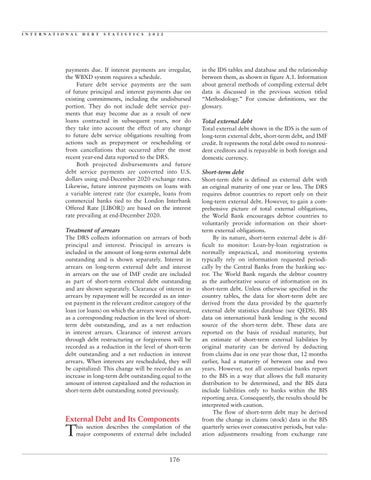I N T E R N A T I O N A L
D E B T
S T A T I S T I C S
2 0 2 2
payments due. If interest payments are irregular, the WBXD system requires a schedule. Future debt service payments are the sum of future principal and interest payments due on existing commitments, including the undisbursed portion. They do not include debt service payments that may become due as a result of new loans contracted in subsequent years, nor do they take into account the effect of any change to future debt service obligations resulting from actions such as prepayment or rescheduling or from cancellations that occurred after the most recent year-end data reported to the DRS. Both projected disbursements and future debt service payments are converted into U.S. dollars using end-December 2020 exchange rates. Likewise, future interest payments on loans with a variable interest rate (for example, loans from commercial banks tied to the London Interbank Offered Rate [LIBOR]) are based on the interest rate prevailing at end-December 2020.
Treatment of arrears The DRS collects information on arrears of both principal and interest. Principal in arrears is included in the amount of long-term external debt outstanding and is shown separately. Interest in arrears on long-term external debt and interest in arrears on the use of IMF credit are included as part of short-term external debt outstanding and are shown separately. Clearance of interest in arrears by repayment will be recorded as an interest payment in the relevant creditor category of the loan (or loans) on which the arrears were incurred, as a corresponding reduction in the level of shortterm debt outstanding, and as a net reduction in interest arrears. Clearance of interest arrears through debt restructuring or forgiveness will be recorded as a reduction in the level of short-term debt outstanding and a net reduction in interest arrears. When interests are rescheduled, they will be capitalized: This change will be recorded as an increase in long-term debt outstanding equal to the amount of interest capitalized and the reduction in short-term debt outstanding noted previously.
External Debt and Its Components
T
his section describes the compilation of the major components of external debt included
176
in the IDS tables and database and the relationship between them, as shown in figure A.1. Information about general methods of compiling external debt data is discussed in the previous section titled “Methodology.” For concise definitions, see the glossary.
Total external debt Total external debt shown in the IDS is the sum of long-term external debt, short-term debt, and IMF credit. It represents the total debt owed to nonresident creditors and is repayable in both foreign and domestic currency.
Short-term debt Short-term debt is defined as external debt with an original maturity of one year or less. The DRS requires debtor countries to report only on their long-term external debt. However, to gain a comprehensive picture of total external obligations, the World Bank encourages debtor countries to voluntarily provide information on their shortterm external obligations. By its nature, short-term external debt is difficult to monitor: Loan-by-loan registration is normally impractical, and monitoring systems typically rely on information requested periodically by the Central Banks from the banking sector. The World Bank regards the debtor country as the authoritative source of information on its short-term debt. Unless otherwise specified in the country tables, the data for short-term debt are derived from the data provided by the quarterly external debt statistics database (see QEDS). BIS data on international bank lending is the second source of the short-term debt. These data are reported on the basis of residual maturity, but an estimate of short-term external liabilities by original maturity can be derived by deducting from claims due in one year those that, 12 months earlier, had a maturity of between one and two years. However, not all commercial banks report to the BIS in a way that allows the full maturity distribution to be determined, and the BIS data include liabilities only to banks within the BIS reporting area. Consequently, the results should be interpreted with caution. The flow of short-term debt may be derived from the change in claims (stock) data in the BIS quarterly series over consecutive periods, but valuation adjustments resulting from exchange rate
